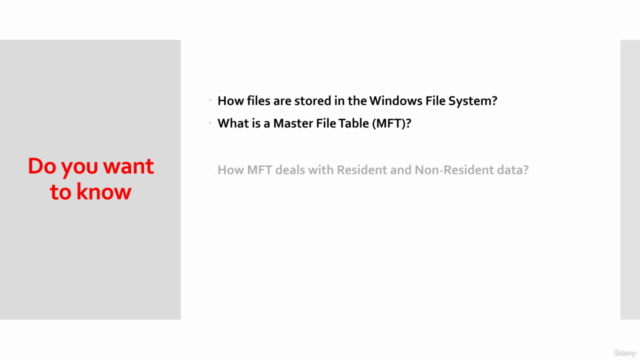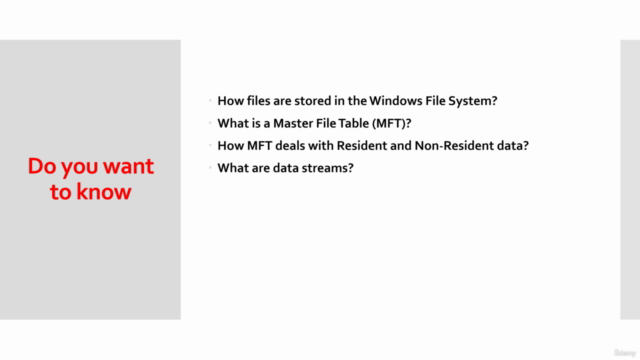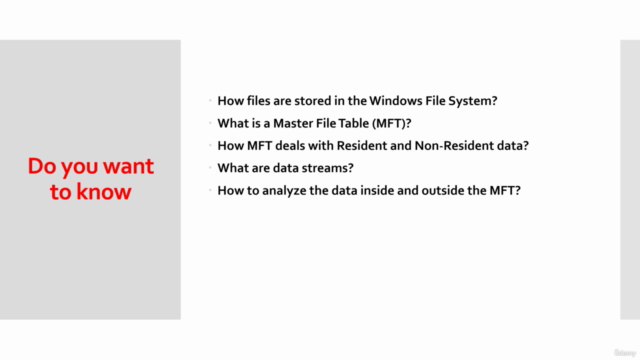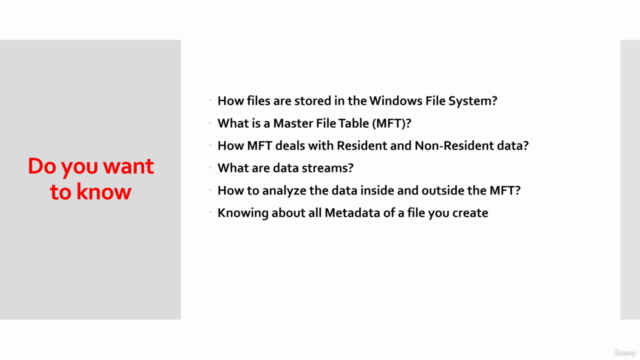Cyber Forensics: Analyzing Data Streams in NTFS

Why take this course?
👩💻 Cyber Forensics: Analyzing Data Streams in NTFS 🕵️♂️
Course Headline: Unlock the Secrets of Cyber Data with Cyber Forensics: Analyzing Data Streams in NTFScourse – Master the Art of Adding and Analyzing Resident and Non-Resident Data in NTFS Data Streams and the Master File Table using Hex Editors!
Course Description:
Are you ready to dive into the world of hidden data within Microsoft Windows File System (NTFS)? This course is your gateway to mastering the intricacies of the Master File Table (MFT) and understanding how data is stored in both primary and alternate data streams. 🗂️
What You'll Learn:
-
Understanding NTFS Basics: Get acquainted with the structure of NTFS, the role of the MFT, and how it indexes files and tracks file system metadata.
-
Data Streams Explained: Learn the difference between resident (≤512 bytes) and non-resident (>512 bytes) data streams, and comprehend how alternate data streams (ADS) can be used to hide information. 🔍
-
Hiding Data in ADS: Discover techniques for adding both resident and non-resident data into primary and alternate data streams, and understand the implications for forensic analysis.
-
Data Analysis Techniques: Analyze resident data within the MFT using common Hex Editors, and pinpoint the exact cluster/sector address on the hard disk where non-resident data resides. 🛠️
-
Verifying Non-Resident Data: Learn to verify the presence of non-resident data in any data stream with the help of specialized Hex Editors, ensuring no stone is left unturned in your forensic analysis.
-
Practical Forensics Tools: Get hands-on experience with forensic tools and Hex Editors to analyze data in the MFT and other locations, turning theory into practice. 💻
Why Take This Course?
This course is an essential tool for anyone interested in the field of computer forensics or those who wish to understand how data can be stored and recovered from NTFS file systems. Whether you're a student, IT professional, or cybersecurity enthusiast, this knowledge will empower you to perform sophisticated forensic analysis on Windows-based systems.
What You'll Gain:
- A solid grasp of the complexities of the NTFS file system and its data streams.
- The ability to identify, analyze, and recover hidden data using Hex Editors.
- Practical skills with forensic tools that will aid you in real-world scenarios.
Who Should Take This Course?
This course is designed for:
- Aspiring Forensic Analysts: Those who want to break into the field of cyber forensics.
- IT Professionals: Individuals seeking to enhance their understanding of file systems for better data management and recovery.
- Cybersecurity Enthusiasts: Hobbyists and students eager to learn more about digital forensics and hidden data analysis.
Join us on this journey to uncover the mysteries of data streams within NTFS, and gain a competitive edge in the cyber forensics domain! 🚀
Enroll now and take the first step towards becoming an expert in digital forensics with "Cyber Forensics: Analyzing Data Streams in NTFScourse" by Cyber Imaginations. Let's decode the hidden data together! 🕵️♀️✨
Course Gallery




Loading charts...